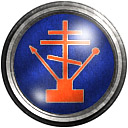Russia (M2TW Faction)
| Russia (M2TW Faction) | |
|---|---|
 | |
| Name: | Russia |
| From Game: | Medieval II: Total War |
| Religion: | Orthodox |
| Culture: | Eastern European |
| Playable: | |
Overview
Russia, the name for the slavic people north of the Black Sea, comes from the Slavic tribe Rus. The Rus who first played a major role in history during the first siege of Constantinople. Afterwards, the pagan Rus settled in what is now modern Kiev. They then became Orthodox Christians and ended up growing to be one of the strongest and largest countries in the world (USSR).
Religion
The Russians are one of the few Orthodox Christian factions in the game. To the south of you is the other Orthodox Byzantine Empire. To the south west, there are the Catholic Polish and the Hungarians Located to the south over the Black sea, or over the Caucasus Mountains are the Islamic Turks. Because of the fact you aren't Catholic, you have no direct relation to the pope. Because of this fact you don't participate in the Crusades, and are under no pressure from the Papal States. Also due to this fact you are under no pressure from the Islamic factions to participate in Jihads.
Military
Infantry- The Russians have weak early infantry units, meaning your regular militia/peasant units. However in the high period they already have fairly good units such as the Dismounted Boyar-Sons/Druzhina. In addition, they get decent spearmen and their most useful infantry unit - the Dismounted Dvor. Those elite units can double as both great archers and a decent hand-to-hand unit. In the late period they can get the Berdiche axemen who are a good shock unit for breaching enemy lines. As nearly all Russians use axes they are useful against the armour of the dismounted European knights.
Cavalry- Cavalry is the mainstay of the Russian army. The Russians specialize in horse archers (Kazaks, Cossack Cavalry) and have excellent dual use cavalry (Boyar Sons, Dvor). In particular, the Boyar Sons can pepper the enemy with javelins and then surprise them with a full charge. The Dvor fill the heavy horse archer role and are capable in hand to hand combat as well. Though most Russian cavalry don't use lances (except the late period bodyguard) their Druzhina and the excellent late period Tsar's guard can challenge any contemporary western knight. In hand to hand combat the Russian cavalry usually use axes.
Ranged- The Russians start with fairly weak peasant archers. As they progress they can build crossbow militia in the cities and the dual use Dismounted Dvor unit in the castles. Most of Russia's cavalry is also ranged (read above). The Russians really shine with their Cossack Musketeers whose long range is particularly useful against the Mongol ranged units. They can also get the fearsome Basilisk cannon, and put guns on their late period fleets.
A note on fashion- If you have good armouries it can be pretty amazing to see the Russian spear, crossbow and yearly bodyguard units radically change their appearance on the battle map.
Economy
Many of the lands you will acquire early on in your Russian campaign will have little resources. Meaning that in the beginning of the game your treasury is almost empty every turn. In order to sustain a good economy, capture as many cities on the Baltic Sea as soon as possible and build ports for naval trade. You then need to build roads in every settlement and hire a lot of merchants because there is a lot of fur, wood and amber resources lying around the Russian plains. After gaining a few rebel territories, you will need to try to capture southern provinces such as Kiev and Caffa, for Black sea trade. This will be important for trade with Mediterranean factions.
Expansion
Despite Russia's slow economy and weak early game army, Russia is given many rebel provinces to expand upon. The starting town is surrounded by 3 rebel settlements. This is important because, if you get there early enough in the game there shouldn't be a garrison in the villages. (Smolensk, Riga and Helsinki). Vilnius can be tough as it has a large garrison, so it may be wise to wait for the Poles to weaken it. Once you got your 5 most critical provinces (Riga, Helsinki,Vilnius, Smolensk and obviously Novgorod) under control, you can start the big expansion. Directions are the many rebels to the east, to the south is Kiev and access to the black sea, or you can take on Poland/Hungary in the west. There is also the possibility of landing in Norway and getting to the Danes and Holy Roman Empire from the North.
Summary
The Russians start with one city and a potential to expand. Their large steppes can be tough to defend, but they do have a cavalry oriented Army. They also need to be wary of Mongol and Timurid invasions. However if Russia can defend its borders and withstand the invaders the way is open in any direction, with a powerful mobile army.
Their victory conditions are: For a short campaign- 15 provinces and destroying Poland + Hungary. For a long campaign- 45 provinces including Constantinople and Jerusalem.
| Medieval 2: Total War | Factions: |
|---|
| Aztecs | Byzantine Empire | Denmark | Egypt | England | France | Holy Roman Empire | Hungary | Milan | Mongols | Moors | Papal States | Poland | Portugal | Russia | Scotland | Sicily | Spain | Timurids | Turks | Venice | Rebels |